So, you’re shopping for a new roof and don’t know if you want traditional asphalt shingles or a metal roof? When comparing asphalt shingles vs metal roofing, it’s best to consider long term. Asphalt shingles are cheaper, but metal lasts longer. Metal roofing is recyclable while asphalt shingles aren’t. There are more metal roofing options to consider, today, such as stone-coated metal shingles or standing seam panels. Maybe you’re tired of replacing your traditional asphalt shingle roof every 20 years or so and would like something that lasts longer? In this article, we compare the pros and cons of traditional asphalt roofing shingles to metal roofing options, and in the end, we pick our favorite steep slope roofing material.
Short Answer: When comparing asphalt shingle roof vs metal roof, if you’re interested in low initial cost, stick with asphalt shingles. Otherwise, choose any metal roofing product if you’re more interested in longevity and low long-term cost. If you want the coolest roof, you want standing seam or corrugated/PBC.
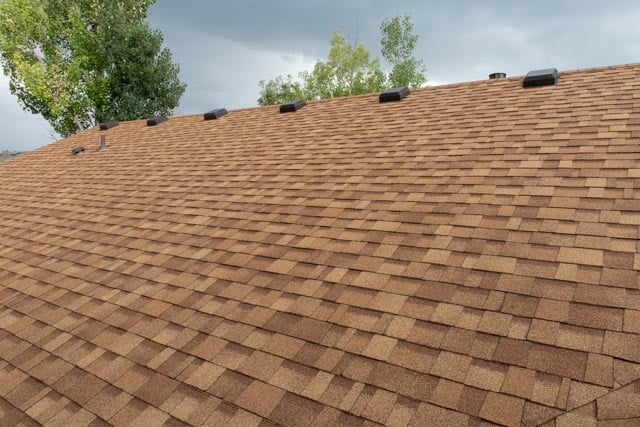
Asphalt Shingle Types and Features
Your general options for asphalt shingles come down to these:
- 3-Tab/Strip, Architectural/Designer, or Luxury Shingles
- 25-Year or Limited Lifetime Limited Warranty
- Less or More Wind Resistance
- Less or More Impact Resistance
- Energy Star Rated or Not
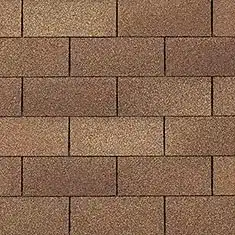

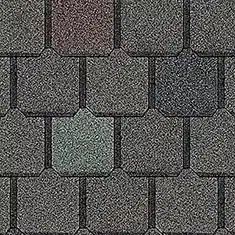
3-Tab Shingles
3-tab, also known as strip shingles, are your least expensive. See Owens Corning’s Supreme or CertainTeed’s XT-25. These often come with the shortest warranty, and the least protection, such as from hail and high winds. 3-tab shingles offer a very flat look to your roof. You can expect around 15 years out of these shingles.
Dimensional/Architectural Shingles
Dimensional or Architectural shingles, such as Owens Corning’s TruDefinition Duration or Tamko’s Titan are more expensive than 3-tab, but often come with better protection, such as from high winds, and longer warranties. Dimensional shingles, as the name implies, give your roof a little more depth. You can expect around 25 years out of these shingles.
Luxury/Designer Shingles
Luxury shingles, such as Owens Corning’s Woodmoor or CertainTeed’s Grand Manor, are often the most expensive asphalt shingles. Oddly enough, most of these high-end shingles lack some of the best features and protections, such as impact resistance or solar reflectance, and some don’t last as long as architectural shingles do.
Metal Roofing Options
- Standing Seam
- Corrugated/PBC
- Stone-Coated Metal Shingles
With metal roofing, your options are standing seam, corrugated/PBC, and stone-coated metal shingles or tiles. All of these metal roofing products last a lot longer than even the longest-lasting asphalt shingle. You can expect at least 70 years out of a new metal roof.
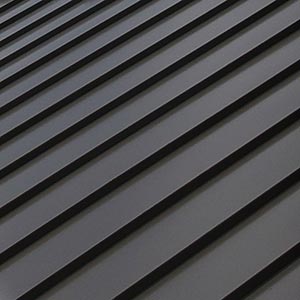


Standing Seam
With standing seam panels, you have two gauges (thicknesses) to choose from. The thicker the gauge, the heavier, longer-lasting, more durable, and the more expensive it is. You also have dozens of colors to consider. Dozens! All are more impact and high-wind resistant than the most durable asphalt shingle, so you don’t have to worry about these features. Although there are multiple profiles available for standing seam, we usually determine which profile is best based on the location and orientation of the building to the prevailing wind, and the pitch of your roof.
Corrugated/PBC
As with standing seam, there are a few gauges/thicknesses to choose from with corrugated/PBC metal roofing: 22, 24, 26, and 29 – the smaller the number, the thicker and more expensive the metal. Corrugated/PBC sheet metal has all the same advantages as standing seam with one addition: it’s even more durable since there are no flat surfaces.
All metal panels are energy efficient, so this, too, is something you don’t have to think about. In fact, metal roofing panels are the most energy efficient steep sloped roofing material available and are considered the ‘coolest’ roofing material.
Stone-Coated Metal Shingles and Tiles
Stone-coated metal shingles, such as Westlake Royal Roofing’s Pine Crest Shake, on the other hand, are structurally similar to asphalt shingles, except instead of a fiberglass foundation, they have a metal foundation. On top of that, there’s asphalt and granules, just like asphalt shingles. With these metal shingles, you get the appearance of traditional shingles, yet a roof that lasts a lot longer. Stone-coated metal shingles are among the least ‘cool’, however, unless you get white, which is still not even close to being as energy efficient as metal panels.
Metal shingle profiles include wood shake, traditional shingle, and tile. If you’re wanting to replace your asphalt shingle roof with something that looks similar to traditional shingles, you can do that. If you’re replacing your old wood shake roof and want something that looks similar to real wood, you can do that, too, with stone-coated metal shingles. Or if you’re wanting a southwestern, Italian, or Mediterranean look, you can have it with stone-coated metal tiles.


Asphalt shingles have been around since the early 1900s. Since then, they’ve seen some changes of their own. Today, they use a fiberglass base instead of felt or asbestos, which makes them more resistant to fire. There are more color options available, today, and more resistance to hail.
Metal roofing has been around a lot longer than asphalt shingles. It dates back to the 200s when copper shingles were used in South Asia. Metal roofing has changed a lot since then. Today, there are stone-coated metal roofing, which came about during the early 1940s in the UK. These stone-coated metal shingles look quite a bit different from the original copper shingles. There’s also metal panels, such as standing seam. These panels are made from galvanized and galvalume steel. We unroll, form, and cut these on location. These, too, are quite unlike the original copper shingles from the 3rd century.
Now that we’ve discussed the options for asphalt shingles vs metal roofing, let’s see their advantages and disadvantages.
Advantages of Traditional Asphalt Roofing Shingles
- Most Affordable, Initially
- Flexible
- Quick to Install
- Decent Number of Color Choices
Most folks choose traditional asphalt shingles because they are the least expensive, initially. They come in a decent number of colors to choose from. Most asphalt shingle manufacturers offer any one line of shingles in a dozen or so colors. There are also several asphalt shingle manufacturers too choose from, including Owens Corning, CertainTeed, GAF, Tamko, and Malarkey. Because asphalt shingles are made from fiberglass and asphalt, they’re relatively easy to cut with a utility knife, which makes them flexible, and quick to install and cut.
Disadvantages of Asphalt Shingles
- Non-Recyclable (in our area, anyway)
- Short-Lived, Compared to Metal Roofing
- Low Solar Reflectivity
- High Long-Term Cost
The disadvantages of asphalt shingles are that they are relatively short-lived, compared to metal roofing. On average, asphalt shingles last between 15 and 30 years, here in Colorado, with our high winds and large hail. As a result, they often cost more in the long-term compared to metal roofing. Asphalt shingles are not recyclable in our area. This means they’re getting buried in our backyards. Asphalt shingles have a low solar reflectivity score. This translates to them not being as energy efficient as metal roofing panels.
Advantages of Metal Roofing
- Long Lasting
- Less Expensive in the Long Run
- Resemble Other Roofing Materials Better, Such as Wood Shake
- Recyclable, as a Result are Considered More ‘Green’ Than Asphalt Shingles
- ‘Cool’
- Metal Roofing Panels Offer More Color Choices
The advantages of metal roofing are great. Namely longevity. Any metal roofing product often lasts at least 3 times as long as even the longest-lasting asphalt shingle. This means it also costs less in the long run. Any metal roofing product is also much more resistant to high winds and hail storms. All metal roofing products are also recyclable, unlike asphalt shingles. Metal panels are the ‘coolest’ roofing material, meaning they help to lower your Summer utility bill. Lastly, metal panels come in way more colors than asphalt shingles.
Disadvantages of Metal Roofing
- Prone to Dents from Large Hail Stones
- More Expensive, Initially
- Takes Longer to Install
The disadvantages to metal roofing are few. The biggest being that they are more expensive, initially. You can expect to pay as much as 3 times as much to install a metal roof compared to asphalt shingles. This is partly due to the fact that metal roofing takes longer to install. Metal panels are prone to dents from large hail stones, such as 2″ or greater. This is purely an aesthetic disadvantage.
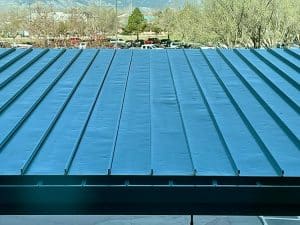
The Bottom Line
When comparing asphalt shingles vs metal roofing, be sure to keep in mind what’s important to you. Although asphalt shingles are initially less expensive than metal roofing, we think you’ll find metal roofing, especially metal panels, superior in every way – they last longer, are recyclable, are more durable, cooler, and cost less in the long-run. In addition, a metal roof fits right in here in Colorado 🙂
If your concerns are low initial cost, go with traditional asphalt shingles. If you can spend more initially, and you’re more interested in low long-term cost, longevity, durability, recyclability, and resistance to hail, fire, and wind, choose any metal roofing product mentioned above. However, if you’re also interested in the coolest or most energy efficient roof, go with corrugated/PBC metal roofing, as this roof will help to cool your home the most.

